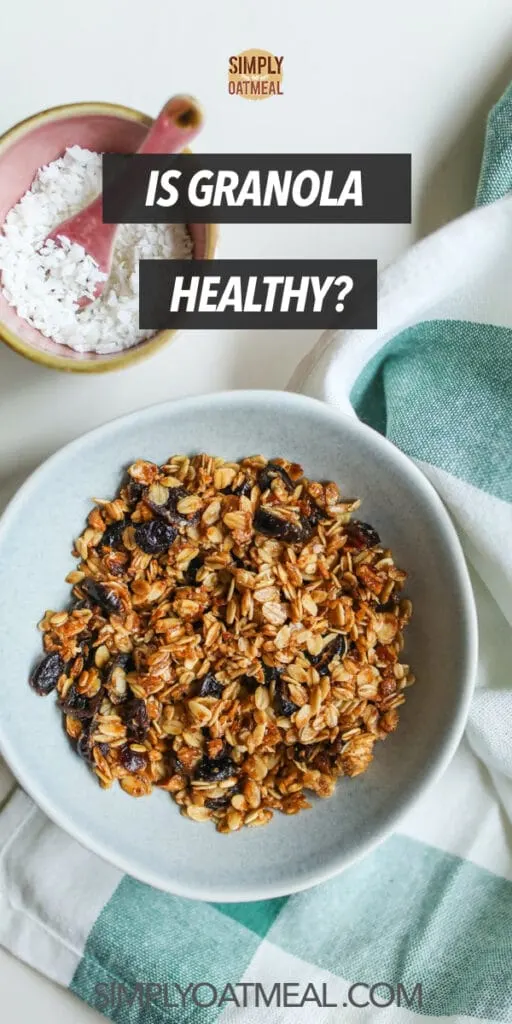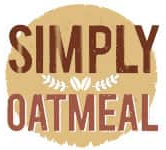In general, granola is considered to be healthy breakfast cereal. However, that is not the extent of its limitations and granola is eaten as a snack by the handful, on top of yogurt, ice cream and baked cobblers for dessert.
What is granola? Granola is a toasted mixture of rolled oats, nuts, dried fruits, seeds, sweetener like maple syrup, honey or sugar, and oil for browning. There is no set list of ingredients, and granola can be made with any combination of cereal grains, there are even keto varieties that do not have any grains at all.
Granola recipes are not bound to specific proportions or ingredients. It may also include other grains, like spelt, sorghum, millet or puffed rice to name a few, along with spices, nut butters, or chocolate in any combination.
This article explains what granola is, nutritional information, whether or not it is healthy and examines the benefits and downsides to eating granola on a regular basis.
Is granola healthy?
Granola is usually an extremely healthy blend of whole grains, nuts, seeds, dried fruits, etc are all wholesome ingredients. The health concern arises when considering the amount of sweeteners and oil used for making crunchy granola clusters.
The addition of chocolate, oils and syrups adds sugars and fat to the hearty mixture. Though it is necessary to bind the clusters and give their signature crunch, the amounts vary drastically between brands.
Reducing the amount of sugars and oils will have a significant impact on the healthiness of the granola. Let’s take a look at the nutritional information for a few well know brands.

Granola Nutritional Information
Granola is a calorie-dense prepared food that is a rich source of protein, fiber, and essential micronutrients like iron, magnesium, zinc, copper, selenium, B vitamins, and vitamin E.
Depending on the specific ingredients used, the nutritional profile can vary greatly. Some varieties are low in fat and calories, while others others are high in fat and calories due to the higher amounts of protein and fiber.
A general rule of thumb, nut and seed based granolas are higher in protein, with more dried fruits or sweeteners are higher in sugar and those with more whole grains are higher in carbs and fiber.
The nutrient levels in granola will vary based on the ingredients used in the mixture. Though granola is a good source of fiber, the added fats and sugars are of concern.
Benefits of granola
Since it is a prepared food that is made with a wide range of ingredients, there is little scientific research on granola by itself. Common ingredients include oats, seeds, and nuts, which are all connected to a number of health benefits.
Noteworthy of a mention, most granolas are a generous source of plant based protein and dietary fiber. Both macronutrients are associated increased levels of fullness, which can improve weight loss due to reduced cravings.
Increased Feeling of Fullness
Protein even have an effect of ghrelin and GLP-1, which are hormones that play an important role in the feeling of fullness [1, 2, 3].
Nuts and seeds are the predominant source of protein in granola. Walnuts, cashews and almonds are nuts commonly added to granola. Flax, pumpkin, chia, sesame and hemp are seeds commonly added to granola.
In addition to providing sources of plant based protein, oats, nuts and seeds are high fiber foods. Fiber slows the emptying of your stomach content which improves nutrient absorption and extends the feeling of fullness that may impact appetite control [4, 5].
Other health benefits of granola
Granola may also provide additional advantages:
- Improve cholesterol levels. Oats contain beta glucan, which is a soluble fiber that helps reduce cholesterol levels, including LDL or the bad cholesterol which is linked to risk factors associated with heart disease [6, 7].
- Reduce blood sugar levels. Whole grains, seeds, nuts, and dried fruit may help control insulin spike in the blood. This may be significant for those with prediabetes or obesity (8, 9, 10).
- Reduce blood pressure. High-fiber foods like oats, nuts and seeds have demonstrated the ability to reduce blood pressure (11, 12).
- Rich source of antioxidants. Ingredients like oats, coconut, seeds, and nuts are good sources of antioxidants that work to fight against inflammation (15, 13, 14).
- Beneficial for gut health. The whole grains and fiber rich nuts and seeds encourage healthy gut bacteria as opposed to other types of breakfast cereal.
Easy grab and go
Granola is a snack time favorite for many people whole need a quick bite packed with a large burst of energy. It is a calorie dense food with fat, fiber, protein and carbs to keep you energized.
From kids lunches to backpackers and hikers, granola is easy to store, lasts a long time and transports well. It requires nothing else, except for being hydrates because it is a very dry food.
Each serving provides complex carbs and protein to keep you energized for endurance activities.
Granola is made into large crunchy cluster, individual crumbles and also into convenient snack bars that make it easier to portion and carry on the go. Although granola bars are easier to transport, they often times contain more sugars, oils and additive ingredients.
Many pre-made granolas contain healthy ingredients that offer proven benefits including anti-inflammatory antioxidants, lower blood pressure, improved cholesterol, blood sugar levels, and digestive health.
Disadvantages of granola
Although granola may contain several healthy ingredients, the high fat, high sugar and carb rich food may be a concern for some people.
Fats from the coconut oils, vegetable oils and nut butters are used to coat the dry ingredients and bind them together. When cooked, the mixture forms large clusters that are packed with flavor and toast with a crunchy texture.
It’s the fats and sweeteners that increase the caloric content and impact the overall health of the power packed blend. Eating more calories than you burn will lead to weight gain and increase the risk of obesity or weigh related diseases [15].
According to the U.S. Department of Agriculture (USDA), sugar intake should be limited to 10% of your total daily calories. If you are following a 2,000-calorie diet, that is about 12 teaspoons or 50 grams of sugar [16].
This isn’t the case for every brand, some granolas may contain as much as 4 teaspoons of sugar per serving, that’s a whooping 17 grams! Because it is common to eat more than a single serving as listed on the packaging, you could potentially be consuming much more than you anticipate.
Eating too much sugar has adverse health affects, including but not limited to type 2 diabetes, obesity, heart disease, cavities and cancer [17, 18, 19, 20, 21].
Sugar comes in various shapes and sizes. Watch out for artificial sweeteners, honey, syrup, refined sugars and even ingredients like chocolate chips and too much dried fruits.
A caloric input that is higher than the output will leading to eventual weight gain. Though granola has many beneficial ingredients, too much of a good thing can also lead to disadvantages.
In this case, sugars and fats are the leading cause of increased calories. Too much sugar can lead to diseases that turn to chronic health conditions type 2 diabetes, heart disease, and obesity which are hard to reverse.
How to choose the healthiest granola
Ingredients vary between flavors, recipes and brands. It is important to always review the ingredients list on the nutrition label so that you can keep a watchful eye on the items used.
Avoid products that list excessive sugars, syrups and sweeteners like honey, brown rice syrup, corn syrup, or maple syrup in the first few ingredients. The order of ingredients is important as it signifies the largest quantities of each item in the package.
The first few ingredients should be whole foods like oats, nuts, seeds and dried fruits.
Stick with brands that feature higher amounts of protein and fiber. 3 to 5 grams of fiber is a good range to shoot for per serving [22].
Also, keep a watchful eye on small serving sizes. A typical serving can vary between 2 tablespoons (12.5 grams) to 2/3 cup (67 grams).
An extra small serving size can be quite deceiving because typically you are going to eat much more than the portion recommendation. Therefore, you may think you are eating less calories than you really are.
Check out in depth analysis about our favorite granola brands. We have included the best brands for weight loss, the healthiest and of course the most popular.
For best results, we encourage making homemade granola so that you can have more control over the ingredient used. This gives you the best results and it is actually quite easy to do.
It’s best to steer clear of granolas with excessive amounts of added sugar. Read the nutrition facts on the label so that you can select brands that have more fiber and protein.
Or, try making granola yourself so that you can have the taste of homemade in every bite.
Granola: Final Thoughts
Granola is a nutritious, fulfilling dish. Although it is primarily eaten for breakfast as a cereal, it is often used to as a topping for yogurt, ice cream and even on baked goods.
There are many varieties of granola, and each one bears a different set of ingredients that has a large impact on its level of health.
Be careful to read labels of packages so that you can avoid varieties with excessive calories, sugars and fats, each of which can affect your overall health. Too much sugar can lead to irreversible health affects, while too much calories will result in weight gain.
Look for varieties that list whole ingredients like oats, nuts, seeds and dried fruits as the first few ingredient. Find brands that have higher amounts fo protein and fiber, with lower amounts of fats and sugars.
